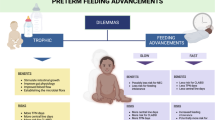Abstract
Objective
We examined the effect of two strategies to prevent necrotizing enterocolitis (NEC) in extremely low birth weight (ELBW) infants—adherence to a standardized feeding protocol and use of a hospital-based milk bank to provide exclusive preterm human milk feedings.
Study design
We conducted a single-center observational study from 2010 to 2015. Infants received preterm human milk, initially trophic feeds from days 7 to 14 after birth, followed by advancement of 15 mL/kg/day to reach a goal of 180 mL/kg/day. Fortification was used selectively for weight gain < 15 g/kg/day. We determined the incidence of NEC, other morbidities, and growth.
Results
The cohort included 398 ELBW infants who survived to day 14 without congenital anomalies. Mean gestational age was 26.2 ± 1.9 weeks. Maternal milk was used as the sole feeding in 62% of infants; preterm donor milk was used solely or as supplement in 29%. Full feeds were reached at a median of 27 (IQR 23, 33) days. Four infants (1%) developed NEC.
Conclusion
Use of standardized feedings with a hospital-based milk bank is associated with an incidence of NEC lower than previously reported.
This is a preview of subscription content, access via your institution
Access options
Subscribe to this journal
Receive 12 print issues and online access
$259.00 per year
only $21.58 per issue
Buy this article
- Purchase on Springer Link
- Instant access to full article PDF
Prices may be subject to local taxes which are calculated during checkout

Similar content being viewed by others
References
Gross SJ, Slagle TA. Feeding the low birth weight infant. Clin Perinatol. 1993;20:193–209.
McNelis K, Fu TT, Poindexter B. Nutrition for the extremely preterm infant. Clin Perinatol. 2017;44:395–406.
Shah TA, Meinzen-Derr J, Gratton T, Steichen J, Donovan EF, Yolton K, et al. Hospital and neurodevelopmental outcomes of extremely low-birth-weight infants with necrotizing enterocolitis and spontaneous intestinal perforation. J Perinatol. 2012;32:552–8.
Jasani B, Patole S. Standardized feeding regimen for reducing necrotizing enterocolitis in preterm infants: an updated systematic review. J Perinatol. 2017;37:827–33.
Quigley M, McGuire W. Formula versus donor breast milk for feeding preterm or low birth weight infants. Cochrane Database Syst Rev 2014: CD002971.
Gephart SM, Hanson CK. Preventing necrotizing enterocolitis with standardized feeding protocols: not only possible, but imperative. Adv Neonatal care. 2013;13:48–54.
Patel RM, Kandefer S, Walsh MC, Bell EF, Carlo WA, Laptook AR, et al. Causes and timing of death in extremely premature infants from 2000 through 2011. New Engl J Med. 2015;372:331–40.
Slagle TA, Gross SJ. Effect of early low-volume enteral substrate on subsequent feeding tolerance in very low birth weight infants. J Pediatr. 1988;113:526–31.
Title 10, Volume C, Section 400.22 Statewide Perinatal Data System. Official compilation of codes, rules and regulations of New York State. Deptartment of State: Albany, 2006.
Bell MJ, Ternberg JL, Feigin RD, Keating JP, Marshall R, Barton L, et al. Neonatal necrotizing enterocolitis. Therapeutic decisions based upon clinical staging. Ann Surg. 1978;187:1–7.
Bifano EM, Curran TR. Minimizing donor blood exposure in the neonatal intensive care unit. Current trends and future prospects. Clin Perinatol. 1995;22:657–69.
Title 10, Volume A-1, Chapter II, Part 52, Subpart 52-9 Human Milk Banks. Official compilation of codes, rules and regulations of New York State. Department of State: Albany, 2000.
Bayley N. Bayley scales of infant and toddler development. 3rd edn. San Antonio, TX: Harcourt Assessment; 2006.
Patel AL, Engstrom JL, Meier PP, Jegier BJ, Kimura RE. Calculating postnatal growth velocity in very low birth weight (VLBW) premature infants. J Perinatol. 2009;29:618–22.
Fenton TR, Kim JH. A systematic review and meta-analysis to revise the Fenton growth chart for preterm infants. BMC Pediatr. 2013;13:59.
Lin PW, Stoll BJ. Necrotising enterocolitis. Lancet. 2006;368:1271–83.
Viswanathan S, McNelis K, Super D, Einstadter D, Groh-Wargo S, Collin M. Standardized slow enteral feeding protocol and the incidence of necrotizing enterocolitis in extremely low birth weight infants. JPEN J Parenter Enter Nutr. 2015;39:644–54.
Cacho NT, Parker LA, Neu J. Necrotizing enterocolitis and human milk feeding: a systematic review. Clin Perinatol. 2017;44:49–67.
Lucas A, Cole TJ. Breast milk and neonatal necrotising enterocolitis. Lancet. 1990;336:1519–23.
Sullivan S, Schanler RJ, Kim JH, Patel AL, Trawoger R, Kiechl-Kohlendorfer U, et al. An exclusively human milk-based diet is associated with a lower rate of necrotizing enterocolitis than a diet of human milk and bovine milk-based products. J Pediatr. 2010;156:562–7. e561
Hair AB, Blanco CL, Moreira AG, Hawthorne KM, Lee ML, Rechtman DJ, et al. Randomized trial of human milk cream as a supplement to standard fortification of an exclusive human milk-based diet in infants 750-1250 g birth weight. J Pediatr. 2014;165:915–20.
Gross SJ. Growth and biochemical response of preterm infants fed human milk or modified infant formula. New Engl J Med. 1983;308:237–41.
Morales Y, Schanler RJ. Human milk and clinical outcomes in VLBW infants: how compelling is the evidence of benefit? Semin Perinatol. 2007;31:83–88.
Mercier CE, Dunn MS, Ferrelli KR, Howard DB, Soll RF, Vermont Oxford Network EIF-USG. Neurodevelopmental outcome of extremely low birth weight infants from the Vermont Oxford network: 1998-2003. Neonatology. 2010;97:329–38.
Hintz SR, Kendrick DE, Stoll BJ, Vohr BR, Fanaroff AA, Donovan EF, et al. Neurodevelopmental and growth outcomes of extremely low birth weight infants after necrotizing enterocolitis. Pediatrics. 2005;115:696–703.
Acknowledgements
We thank Nancy Dock, PhD for her thoughtful review of this manuscript and Charlene Insalaco, RN for her contribution to our human milk bank.
Author information
Authors and Affiliations
Corresponding author
Ethics declarations
Conflict of interest
The authors declare that they have no conflict of interest.
Rights and permissions
About this article
Cite this article
Murthy, S., Parker, P.R. & Gross, S.J. Low rate of necrotizing enterocolitis in extremely low birth weight infants using a hospital-based preterm milk bank. J Perinatol 39, 108–114 (2019). https://doi.org/10.1038/s41372-018-0235-3
Received:
Revised:
Accepted:
Published:
Issue Date:
DOI: https://doi.org/10.1038/s41372-018-0235-3



